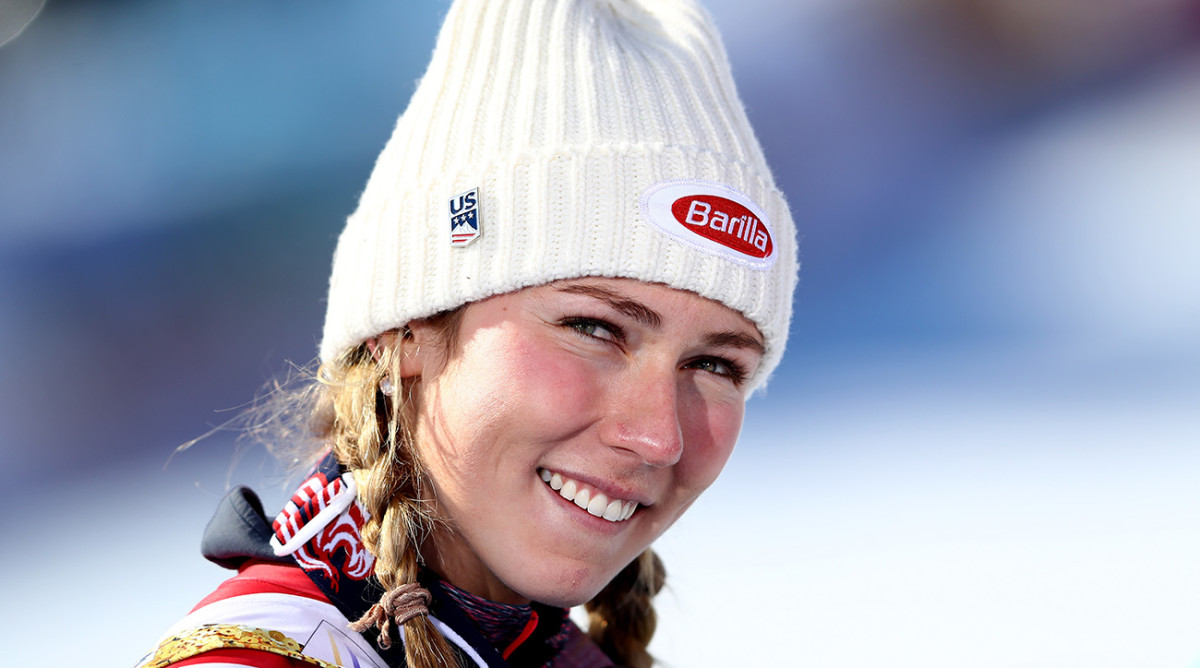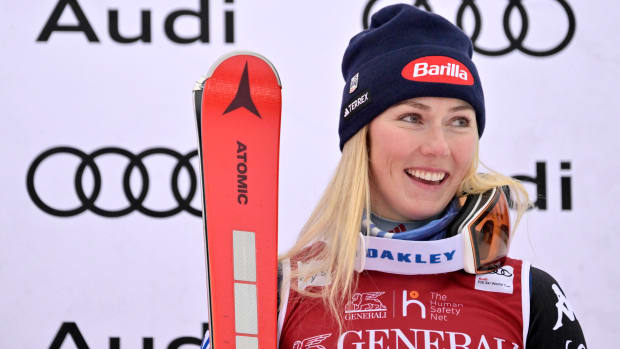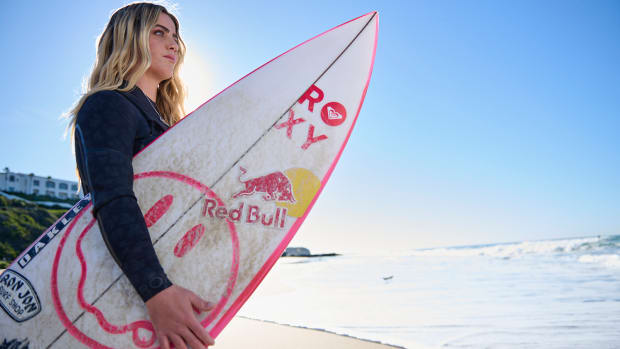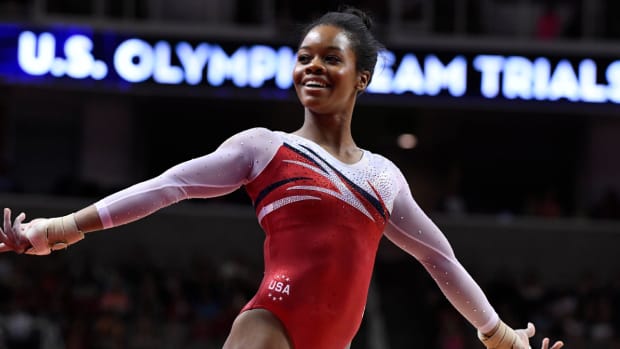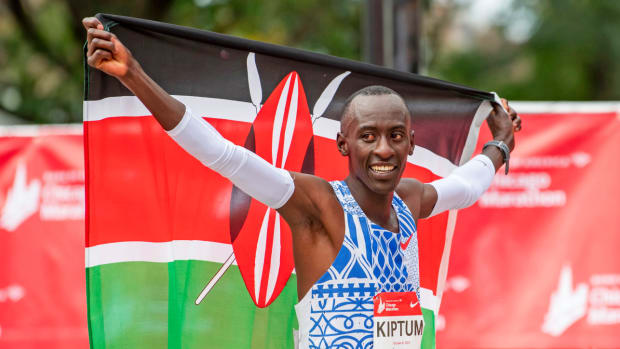As she closes in on first overall World Cup title, Mikaela Shiffrin also readies for Olympic glory
Last Tuesday afternoon in the Swiss resort village of Zinal, 5,500 feet above sea level in the Alps and surrounded by peaks more than twice that high, U.S. alpine ski racer MikaelaShiffrin began planning for Olympic Games that are still a year away. Her support team of five—two coaches from the U.S. Ski team, a trainer, a ski technician and, most importantly, her mother/assistant coach Eileen—gathered and began organizing the days, weeks and months between now and the opening ceremony on Feb. 9, 2018 in Pyeongchang, South Korea. Minutes after that meeting ended, Shiffrin was both emboldened and mildly overwhelmed. “We’re not even done with this year’s World Cup season,” said Shiffrin in a Skype interview. That is true. Shiffrin has at least nine races left in the 2017 season, including two stops in the U.S.: March 10 and 11 in Squaw Valley, Calif., and the World Cup Finals March 15-19 in Aspen, Colo.
But the Olympics beckon long before the pre-Olympic year is finished. I remember standing with U.S. ski racer Bode Miller (who would go on to become the most successful American male alpine racer in history) at the base of race hill in Bormio Italy in February of 2005, as Miller scanned the 12-month horizon and landed on the Torino Olympics. “It’ll feel big, I know that,” Miller said. (Miller, as an aside, has not fully discounted attempting an Olympic comeback in 2018, a possibility that lies somewhere among intriguing, sad and terrifying). Shiffrin has much work ahead in 2017, but every day henceforth is lived in the shadow of the Games.
It’s appropriate to think of Shiffrin, at age 22, as a mature professional athlete. She has been competing in World Cup ski races since she was 16 years ago, and four years ago in the mountains above Sochi, Russia, won the gold medal in the slalom and became, at 18, the youngest U.S. alpine gold medalist in history and the youngest-ever Olympic slalom winner, male or female. Since then, Shiffrin has won 21 more World Cup races, and her total of 28 victories is already 11th on the all-time World Cup women’s list. She has won two more world championships in slalom (and a total of three straight, dating back to 2013), including a gold medal on Feb. 18 at the most recent Worlds in St. Moritz, on top of a silver medal in the giant slalom. She is leading the World Cup overall (all events) points standings and could become just the third U.S. woman to win the overall title, after Tamara McKinney (1983) and Lindsey Vonn (four times, 2008-’10 and 2012). She has lucrative sponsorship deals with numerous companies, including ski manufacturer Atomic, pasta maker Barilla and energy drink powerhouse Red Bull.
Yet, Shiffrin’s place in the ski world, and concurrently in popular culture, is ever evolving. She was very much a known commodity during the 2014 Olympic cycle, and was considered the favorite in the slalom. However, the U.S. team was still packed with stars who helped spread the attention—and attendant pressure. Vonn, whose many injuries have often synched up with Olympic Games, was missing; but 2010 medalists Miller, Julia Mancuso and Andrew Weibrecht were all present and all medaled again, and giant slalom impresario Ted Ligety won gold in his specialty. The table was well-set for Shiffrin’s slalom gold, which came after all those others.
Pyeongchang will be different, although precisely how different remains to be seen. Miller will do what Miller will do, but must be considered a massive longshot to compete. Mancuso, who turns 33 on March 9, has missed the last two World Cup seasons after hip surgery and has achieved one World Cup podium since the 2014 Olympics. Ligety, who will be 33 in August, tore his ACL in January of 2016 and had back surgery last month. Vonn, who will also be 33, in October, missed most of the current season with a fractured and surgically repaired humerus bone in her right arm, but still won a World Cup downhill in Germany and took a bronze medal in downhill at the Worlds. When healthy, she is still very fast. (More on Vonn later). It’s possible that all these veterans—comprising much of the most successful generation in U.S. ski racing history—will race in South Korea. It’s also possible that Shiffrin will bear most of the publicity and expectation herself, and in any case, the Olympic star-making machine is not a volume operation and Shiffrin is near the front of the line.
Budapest withdraws 2024 Olympic bid, Los Angeles and Paris remain
She had a dry run in St. Moritz. No Miller. No Mancuso. No Ligety. No Weibrecht. No Steven Nyman, the veteran speed racer who has won three World Cup races and earned 10 podium finishes in his 12-year career. Only Vonn to share the spotlight. “First Lindsey won her medal, which was unbelievable when you consider that she couldn’t feel her right arm (because of lingering nerve damage),” says Shiffrin. “But after that, with Ted out, with Steven out…. And a lot of people talking about me as the favorite [for gold in slalom and any medal in giant slalom]…. Let’s just say I’m relieved to be on the other side of the world championships, knowing that I got the job done, and knowing that I can handle that pressure. Because I could be in that position again at the Olympics.”
Since Shiffrin won the World Cup slalom season title in 2013, solidifying her status as a ski racing prodigy, discussion has centered on when she will expand her competition program to include the so-called “speed” disciplines of Super-G and downhill, in addition to the “technical races, slalom and giant slalom.” (There is also the combined event, which includes a shortened run of downhill or Super-G and a shortened run of slalom). Sleep-deprived, giddy and, let’s not forget, 18 years old, Shiffrin announced shortly after winning the Sochi slalom, “Right now I'm dreaming of the next Olympics and winning five gold medals.” It was a statement that she regretted making and began walking back almost immediately.
Shiffrin has begun expanding her program, but gradually. Slalom and giant slalom racers perform at high speeds, but Super-G and especially downhill, are breathtakingly faster. Small mistakes can lead to big injuries, yet caution will preclude high finishes. Vonn has won 77 World Cup races (still chasing Ingemar Stenmark’s record of 86), including 66 in downhill and Super-G; her career has been spent straddling the line the separates aggression and danger, where all the great speed racers live. Shiffrin is trying to get there.
“Right now, I am an only-ski-speed-when-I’m-comfortable kind of person,” says Shiffrin. She is comfortable when clear sunshine maximizes visibility and when good weather makes for predictable snow conditions. “If something is tricky with the surface or if visibility is reduced, I tend to take my foot off the gas and live to fight another day,” says Shiffrin. “Or I will just back out of the start and not go at all.” Under the right conditions, she can be a threat in the speed races; she finished fourth in Super-G in Cortina, Italy on January 29. That is closest that she has come to a podium (top-three finish) in a speed race.
“My approach to speed races is going to change with experience,” says Shiffrin. “The more I race in difficult conditions, the more I’ll be able to charge in those conditions. I’m slowly getting more comfortable.” (Shiffrin and all other U.S. women’s team skiers, including Vonn, pulled out of a super combined event Friday in Crans-Montana, Switzerland, citing dangerous conditions).
The most revered ski racers are those who have excelled to some degree in both speed and technical racing, like Miller, Vonn, Hermann Maier of Austria, Marc Girardelli of Luxembourg and Anja Paerson of Sweden. However, it is possible to achieve dominance without crossing over. Stenmark’s 86 victories were all in slalom and giant slalom. Of Shiffrin’s 28 World Cup wins, 24 have been in slalom. But she is on a fast pace; Vonn didn’t win her 28th World Cup race until she was 25, but then won 31 races in the next three years, a blistering pace that was halted by a serious knee injury at the 2013 world championships. Shiffrin suffered her first injury last season, a torn medial collateral ligament and tibial plateau fracture in her right knee. She narrowly avoided tearing her ACL, and did not have surgery. “It felt big at the time, because it was my first big injury,” says Shiffrin. “But in the world of ski racing, with all the major injuries, it was like a broken fingernail.”
Caitlyn Jenner calls out Donald Trump for going back on promise to protect LGBTQ rights
Shiffrin will surely race slalom and giant slalom in South Korea, and probably Super-G and combined. Maybe downhill. All TBD. Combining disciplines makes for harried training. “This year,” says Shiffrin, “I’ve been going totally insane trying to juggle it all.” (It should be noted that Shiffrin says “totally insane” with a laugh, and not with resignation or anger).
So now she looks ahead. To Squaw Valley, to Aspen, to a short family vacation in Hawaii. And then to New Zealand and Chile and the southern hemisphere winter. To the weight room, over and over, and to countless interviews, where journalists like me can set her up for success or failure and ask her to predict the future in a wildly capricious and formless sport. “You try to control everything, but you just can’t,” says Shiffrin. “You get the schedule done, and you know from there, anything can happen. You’re going to lose control of it because of weather or little injuries or world politics. It’s definitely not easy.”
It is the longest year of the Olympian’s life.
